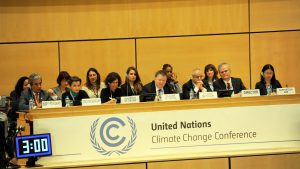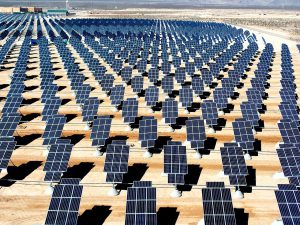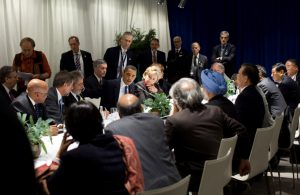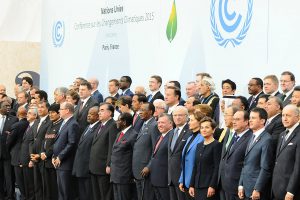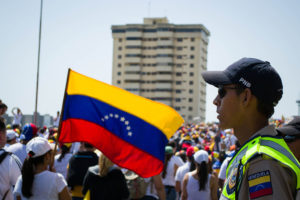chinadialogue: A ‘ratchet and review’ mechanism will be a key part of the Paris agreement as a means of helping set the world on a 2C path, if it is sufficiently robust. How should a ratchet be set to achieve that goal?
Joseph Aldy, associate professor of Public Policy at Harvard Kennedy School, Massachusetts
In order for the submission of Intended Nationally Determined Contributions to drive meaningful, long-term emission reductions, there must be a robust transparency and review mechanism.
Transparency and publicity of a country’s pledge can signal a country’s seriousness and enhance the credibility of its commitment. The review of ex post outcomes can demonstrate whether a country delivered on its pledge and built trust among those participating in an agreement. Designing the institutions to collect, analyse, and disseminate information about countries’ pledges can facilitate positive reciprocal pledging in subsequent negotiations. Transparency would benefit those political leaders who push for their nations to take on more ambitious climate change risk-reduction policies, while raising the costs to those leaders for failing to deliver on commitments by exposing them to domestic political pressure as well as peer pressure.
Transparency mechanisms in other multilateral venues – such as the International Monetary Fund (IMF), the World Trade Organisation (WTO), and Organisation of Economic Development (OECD) – can provide guidance for the design of a rigorous climate transparency regime. Producing credible, independent information through expert review can inform a facilitative peer review. Creating standards and ensuring sufficient resources for domestic data collection and analysis can enhance the capacity in and promote transparency among all countries. Reviews can also promote policy learning and encourage the design of more effective mitigation policies.
Building robust transparency and review institutions in the Paris framework can drive a positive dynamic in which serious mitigation efforts today will lead to more ambitious mitigation efforts tomorrow among all countries. Thus, it is not necessarily the goals set in Paris that will determine long-term warming, but the institutional foundation that could build the trust and create the incentives for countries to ratchet up their mitigation efforts over time.
Eliza Northrop, research analyst for the International Climate Action Initiative, Washington
There are several distinct but integral components to what is referred to at the COP 21 negotiations as the mitigation “cycle”. This is not just a review or assessment but also a window of opportunity for strengthening action. These include: a global “stocktake” every five years to review global progress; updated mitigation “contributions” by countries (akin to INDCs) every five years, informed by the global stocktake; and language in the agreement spurring countries to progressively take more ambitious mitigation action in each “contribution.”
It is crucial that all parties come back within about five years – around 2020 – to either submit a new mitigation contribution, or revisit and increase the ambition of their current mitigation contributions. Unless the Paris decision specifies a collective “moment” to increase ambition around 2020, it will be ten years until parties are required to increase their efforts, making it much harder to limit warming to below 2C.
Waiting will also mean missed economic opportunities and benefits. A lot can change in five years, given the rapid pace of technology, science and policy. It is reasonable to expect that countries will be ready to set more ambitious goals by then – after all, only five years have passed since the last round of pledges was adopted in Cancun in 2010. Waiting ten years to set new goals will miss key opportunities to enhance ambition in the meantime.
Ideally, countries should agree to converge on a common time frame of five years. This convergence could occur from 2025 onwards, with all Parties submitting new mitigation contributions for 2035. However, even if agreement on this is not reached at Paris – it is very important that the agreement still requires every Party to come back every five years and either update or revise and recommunicate their mitigation contribution.
The Paris climate summit needs to negotiate the following related to a stocktake. What will be the inputs to this review? Will it be based entirely on national reporting or include intended mitigation contributions? How will the global stocktake assess the collective effort (e.g. through a synthesis report)? Will recommendations from the review inform the preparation or finalisation of mitigation contributions?
While the first global stocktake under the Paris Agreement would likely occur in either 2023 or 2024, a similar exercise must occur well before 2020 – ideally in 2018, in order to inform the preparation and updating of mitigation contributions ahead of 2020. The global stocktake will not focus only on mitigation progress; it will also consider adaptation, means of implementation and support.
Nick Mabey, chief executive and a founding director of E3G, London
To get near 2C countries will have to change course on what they are prepared to do over the next 5-6 years. If it’s just about submitting or resubmitting INDCs every five years then that wouldn’t be good enough. A ratchet and review system would need to assess the global risks of climate change and how much countries are going to do to alleviate it. Countries could review commitments in 2018 or 2019 as part of a global stocktake and then in 2021 submit their plans for the next phase.
It should be designed in a way that prevents backsliding on previous commitments and increases pressure to do more, but some countries will push back on wording that compels them to more than already-announced targets. China is likely to deliver more abatement by 2030 than is in its INDC and has acknowledged that in its statements.
This means China is probably in a good position to scale up in five years as this would coincide with its five-year economic plans, and it is increasingly requiring transparent data from its companies and cities. But while behind closed doors China is not being supportive of a ‘ratchet’, it is something it may be willing to compromise on as the talks enter their last few days.
Bill Hare, chief executive of Climate Analytics, Berlin
For a safer guardrail against dangerous climate impacts, the world must hold warming to 1.5C. This requires collective action. The whole notion of an agreement is having everyone moving in the same direction, with the same rhythm.
We need points along the way where governments can come together in a common political moment that drives the development of their national policies and actions. They can see what everyone else is doing, and have a chance to examine whether their own action is enough.
And of course you need a goal to measure that against. And that is where 1.5C is important.
Five years is that kind of momentum – we cannot afford to wait 15 years – until 2030 – to look at how we’re doing, until 2030. If we want to have any hope of keeping warming to 1.5C, we need action, and we need to be able to regularly measure whether we are taking enough action to get there. So a ratchet needs to start straight away.
Its scope is also important – not just in terms of cutting emissions, but we also need to be looking for other gaps. How are we doing on climate finance? Are governments mobilising enough funds into the Green Climate Fund and the Adaptation Fund? How are they doing in terms of adaptation? Where are the gaps? Without a regular way of collectively examining all these areas, without a way of keeping up the pressure to improve our action, we risk failing.
At the end of the day, climate change waits for nobody.
Mohamed Adow, senior climate adviser at Christian Aid, London
The national emissions reduction plans outlined within countries’ INDCs are a positive step and show the world is in the middle of a low carbon transition. But the UN Development Programme estimates that added together, these will limit global warming to between 2.7C to 3.5C above pre industrial levels when we need this to be well below 2C. Almost all countries at the summit in Paris have said they want to go further and limit average temperature rise to 1.5C.
But in order for these not to be empty words, they need a ratchet mechanism that will review current pledges no later than 2019 and force countries to strengthen these every five years. Otherwise we’re in danger of locking in low ambition when we could be doing more. A lot can change in four years. For example, the cost of solar energy is likely to continue to fall.
